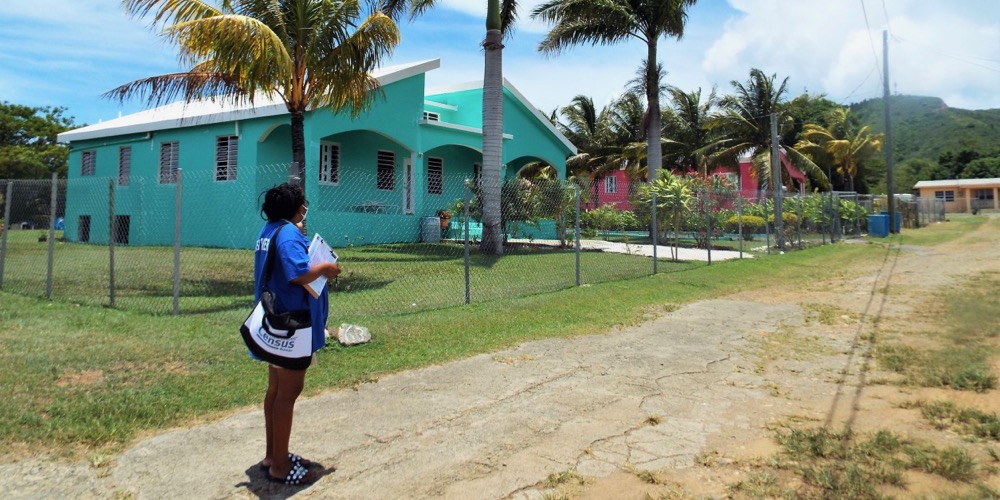
Are you satisfied with the quality of the public schools in the Virgin Islands? How about the roads? Or the hospitals?
Federal funding is critical for maintaining and upgrading all of the above, plus food stamps and housing vouchers, grants for public and private agencies for sports, arts, law enforcement and agriculture and countless other programs.
Funding for all of these depends on the size of the population, and in the U.S. Virgin Islands – unlike many jurisdictions within the states and Puerto Rico – the opportunity to count the total population comes only once every 10 years.
And time is running out. The deadline is Sept. 30.
COVID-19 brings unprecedented challenges
This year, during the 2020 census, the window for counting the population in the Virgin Islands has been cut by a third because of the outbreak and spread of the COVID-19 pandemic. Census directors throughout the country are feeling the pressure.
“The occurrence of the virus has made an enormous difference,” said Dr. Frank Mills, the manager of the census in the St. Thomas-St. John District.
Mills is also vice provost for research and public service at the University of the Virgin Islands and the acting director of the Eastern Caribbean Center and began doing census work in the territory in 1980. He’s been directing the census in the territory since 1990.
Mills said he faced operational issues from a hurricane in the 2000 census, but “this is the first time we’ve ever been interrupted like this.”
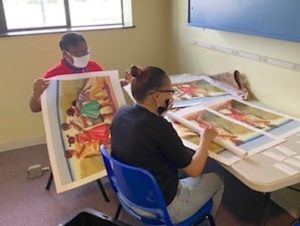
The pandemic has created numerous challenges this year. Enumerators (workers who go door to door to gather the data from residents) officially began counting households on March 1. Only three weeks later – March 22 – operations in the Virgin Islands were halted because of the COVID-19 pandemic. On June 1, after additional training in health and safety protocols, enumerators went out again, only to be recalled again on Aug. 17.
Some census workers have been permitted to continue data collection by phone (for households that have already been officially contacted but not yet interviewed by enumerators). Now Mills is hoping that Gov. Albert Bryan Jr. will allow door-knockers to get back into the field this week.
Assuming workers are allowed to conduct interviews house-by-house, they now have only a month to finish collecting the vital information – a month that coincides with the peak of hurricane season.
Unlike in the states, where the public can also fill out census forms online or through the mail, residents of the Virgin Islands can only respond to the questions in-person or by telephone.
Mills said census takers have completed interviews for more than 50 percent of the households in the Virgin Islands. In the United States, the rate of completion now is around 76 percent.
The pressure to complete data collection is not entirely due to the pandemic but also to politics. According to a recent article in the New York Times, census managers last month received an order “to finish the count a month early, guaranteeing that population figures will be delivered to the White House while President Trump is still in office.”
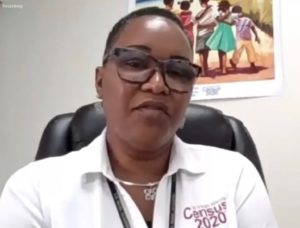
The Times article outlines numerous problems with data collection throughout the United States and Puerto Rico, including the loss of nearly one-third of all trained census workers because of the pandemic and other factors.
Mills confirmed that maintaining personnel in the Virgin Islands has also been a problem.
“Between 35 and 40 percent of those initially trained have left,” Mills said. “We’ve been rehiring right along.”
The census 2020 now employs 240 workers on St. Thomas and 21 on St. John, according to Mills. Lorna Williams-Sutton, manager for the St. Croix District, said there were 279 field workers plus 54 senior staff, supervisors, clerks and security officers on St. Croix. The overall budget for the 2020 census is $19 million.
Information gathered remains confidential
Security is essential, Mills explained.
“We bend over backward to make sure privacy remains intact. Nobody except the census workers and the owners have access to the information. Not the government, not the police can have access to it.”
Williams-Sutton explained that census workers sign an oath to maintain confidentiality for life. The penalty for breaking confidentiality is a $250,000 fine and five years in jail.
Issues for non-citizen residents are resolved
Mills wants to assure immigrants illegally living in the territory that their information will be fully protected and not be given to immigration authorities.
Non-citizen residents had reason to be concerned last year when Trump pushed hard to include a citizenship question on the census, presumably to scare them off from responding. An article on the online news site Vox explains the controversy.
“The census is ideally supposed to count every person residing in the United States – citizens, non-citizen legal residents and unauthorized residents. The state results are particularly important in determining how many seats each state gets in the House of Representatives, and for population-based federal funding formulas.”
“The widespread expectation was that the question would stoke fear among unauthorized immigrants and their family members, scaring off millions of mostly Latino residents from responding, and meaning states where those residents are concentrated will be undercounted. [Those states, which mostly favor Democrats, would then get smaller House of Representatives delegations and less federal funding because of the undercount.]”
The U.S. Supreme Court ended up ruling against the inclusion of a citizenship question (for somewhat complicated reasons explained in the article), but the upshot is that illegal immigrants have nothing to fear by giving out the data sought by enumerators. Immigration authorities “will never get access to that information,” Mills said.
For the 1980 census, enumerators in the territory did meet a fair amount of resistance from non-citizen residents, according to Mills. But the passage of the Virgin Islands Nonimmigrant Alien Adjustment Act of 1981, which granted permanent residency status to many non-citizens in the territory, did much to allay the tension.
Census workers deploy multiple strategies
Mills acknowledged that the territory has sizable populations that speak Spanish and Haitian Creole, so managers have taken pains to hire enumerators who can speak the language of the people they are interviewing.
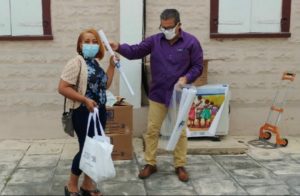
Language is not the only potential barrier census takers encounter.
It’s hard to reach houses locked behind gates. Census takers are not permitted to go beyond a gate or into a home unless invited. Mills said that the response by people living in gated communities on St. John “has been particularly dismal. Most of them totally ignore us.”
On St. Croix, Williams-Sutton said census workers have reached out to property managers in gated communities to encourage residents to be available on scheduled dates.
Field supervisors employ many strategies to make sure every household is counted: Live-aboard boaters are visited by “hull-knockers” who arrive by motorboat.
Establishing a population of more than 100,000 is critical for funding.
There is an additional reason that Mills and his staff are determined to count every resident in the territory this year. If the territory can prove it has a population of more than 100,000, it qualifies for Public Use Microdata Sample. These are files of aggregated data from which the identities of individuals have been removed. Students, researchers and grant writers rely on this data to find answers to questions about a particular segment of the population.
Suppose, for example, you’d like to know how many native St. Johnians live in the territory. This information may not be easily accessed using published U.S. census tables, but it can be gathered using the Public Use Microdata Sample files.
For the past two censuses, the Virgin Islands has shown that it has a sufficient population to qualify for inclusion in the Public Use Microdata Sample. But Mills is concerned that a downward trend in the territory’s population may prevent the islands from being included this year.
In 2000, the population of the Virgin Islands was around 109,000. In 2010, the number dropped to between 105,000 and 106,000.
“We don’t know what the population will be for 2020,” Mills said, “but the closure of HOVENSA in 2012 made a significant difference, and following Irma and Maria, the two storms in 2017, a considerable number of people left the territory. We may drop below 100,000. If we do, we will not get that detailed information from the Public Use Microdata Sample. That’s why participating, and getting to every household, is so very important.”
The 2020 census data will be used for the next 10 years to determine direct support to the territory through federal funding. It will also be used by local agencies seeking funding for federal grants.
Establishing a street address system
There is another way that census data could be updated and made official more frequently than every ten years. Every year, the Virgin Islands participates in the American Community Survey which is conducted throughout the United States and Puerto Rico.
During this survey, a sample of between 2,500 and 3,000 households is taken, and from this data, wider trends are extrapolated. In the Virgin Islands, however, this data cannot be used to apply for federal funding, despite a request by a previous administration to a congressional subcommittee, according to Mills.
“The primary reason we were given is we do not have a street addressing system,” said Mills. Efforts have been made to standardize street addresses in the territory, but the project is still far from complete.
“We are working under the assumption that when we get the street addressing system in place, we will have the right to claim inclusion,” Mills said. “Then, if our population increases, those numbers from the American Community Survey will count.”
Census workers are getting tested for COVID-19
September is now the critical month for gathering census information, and to allay any fears that census workers can spread COVID-19, workers in offices and in the field are now being tested. (Those who are in good standing are also being compensated for their time being furloughed.)
Williams-Sutton said it’s been a challenge to maintain full crews during the pandemic.
“They have valid concerns. Many of the enumerators are retirees or they’re taking care of family members. We had a six-and-a-half-week stoppage. When they came back in June, they already had made plans to travel in the summer.”
Williams-Sutton said enumerators wear masks and interview people (who also must wear masks) from a safe distance, writing the interviewee’s responses on sheets on a clipboard. Enumerators are outfitted with masks, gloves and hand sanitizer.
In spite of precautions, Williams-Sutton said some distrust does exist. If an enumerator encounters someone who refuses to answer the questions, it might simply be a matter of style, she said. A crew leader will try to send a different enumerator the next time; if that fails, then a field operation supervisor goes, and if that doesn’t work an assistant manager will try to make some estimates about the household from what can be seen from outside.
Sprint to the finish
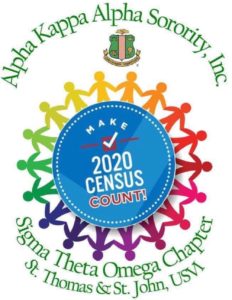
Williams-Sutton said the census has been publicized since October, but to make sure the public understands the importance of the initiative, they’re increasing the visibility. The Census has been working with trusted partners such as AARP, Rotary clubs and sororities, and setting up tents at housing communities where they distribute T-shirts, bags, coloring books and posters along with information.
This year’s poster is by artist Shari Erickson. In 2010, the poster featured a painting by St. Croix artist Leo Carty.
“We have one month to go,” said Williams-Sutton. “Please participate in the census. It’s up to all of us to assure that the Virgin Islands gets its fair share over the next ten years.”


